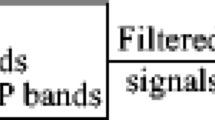Abstract
The pronunciation of a speaker with a defective soft palate is marked by hypernasality and an operation may be necessary to repair the defective soft palate to reduce this hypernasality. An assessment of hypernasality is necessary to quantify the effect of the surgery. The current clinical methods for assessing hypernasality are uncomfortable or require expensive equipment. In this paper, a new quantitative method is proposed to estimate hypernasality. This method requires only a microphone and a personal computer equipped with a sound card. Zeros in the frequency response of the vocal tract system are one of the major characteristics of hypernasality. The proposed method made use of the fact that a linear predictive model with a typical order for the human vocal tract system is not accurate when the vocal tract system has zeros in its frequency response. Hypernasality was estimated by comparing the distance between the sequences of linear predictive cepstrum of low- and high-order linear predictive models. The proposed method provides a better correlation (0.58) with nasalance measured by a nasometer than Teager method (0.44) for all the data. Furthermore, the proposed method showed higher correlation of 0.84 than 0.71 of the Teager method for data with a nasalance higher than 35%. Since the proposed method needs only digitized speech data, it is much less invasive and provides an easy and cost-effective evaluation of hypernasality. © 2001 Biomedical Engineering Society.
PAC01: 4370Dn, 4372Ar
Similar content being viewed by others
References
Cairns, D. A., J. H. L. Hansen, and J. E. Riski. A noninvasive technique for detecting hypernasal speech using a nonlinear operator. IEEE Trans. Biomed. Eng.43:35–45, 1996.
Dalston, R. M., D. W. Warren, and E. T. Dalston. Use of nasometry as a diagnostic tool for identifying patients with velopharyngeal impairment. Cleft Palate J.28:184–188, 1991.
Deller, J. R., J. G. Proakis, and J. H. L. Hansen. Discrete-time Processing of Speech Signals, 1st ed. New York: Macmillan, 1993, pp. 125–127, 266–286, 374–377.
Dickson, D. R. An acoustic study of nasality. J. Speech Hear. Res.5:103–111, 1962.
Gibb, A. G.Hypernasality(rhinolalia aperta) following tonsil and adenoid removal. J. Laryngol. Otol.72:443, 1958.
Gray, A. H., and J. D. Markel. A spectral flatness measure for studying the autocorrelation method of linear prediction of speech analysis. IEEE Trans. ASSP22:207–217, 1974.
Gray, A. H., and J. D. Markel. Distance measures for speech processing. IEEE Trans. ASSP24:380–391, 1976.
Green, M. C. L.Speech of children before and after removal of adenoids. J. Speech Hear. Disord.22:361, 1957.
Hirschberg, J.Velopharyngeal insufficiency. Folia Phoniatr.38:221–276, 1986.
Horii, Y.An accelermetric measure as a physical correlate of perceived hypernasality in speech. J. Speech Hear. Res.26:476–480, 1983.
Horii, Y., and J. Lang. Distributional analysis of an index of nasal coupling (HONC) in simulated hypernasal speech. Cleft Palate J.18:279–285, 1981.
Mammone, R. J., X. Zhang, and R. P. Ramachandran. Robust speaker recognition. IEEE Signal Process. Mag.13:58–71, 1996.
Peterson, G. E.Parameters of vowel quality. J. Speech Hear. Res.4:10–29, 1961.
Rabiner, L. R., and R. W. Schafer, Digital Processing of Speech Signal, 1st ed., Englewood Cliffs, NJ: Prentice Hall, 1978, pp. 82–99.
Schwartz, M. F.The acoustics of normal and nasal vowel production. Cleft Palate J.5:125–140, 1968.
Skolnick, M. L., and E. R. Cohn. Videofluoroscopic Studies of Speech in Patients with Cleft Palate, 1st ed. Berlin: Springer, 1989.
Author information
Authors and Affiliations
Rights and permissions
About this article
Cite this article
Rah, D.K., Ko, Y.I., Lee, C. et al. A Noninvasive Estimation of Hypernasality Using a Linear Predictive Model. Annals of Biomedical Engineering 29, 587–594 (2001). https://doi.org/10.1114/1.1380422
Issue Date:
DOI: https://doi.org/10.1114/1.1380422




